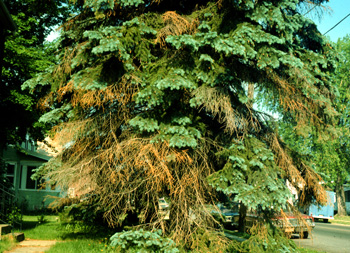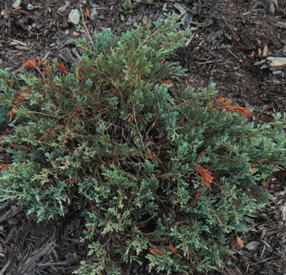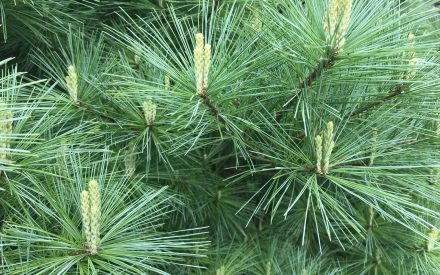
What is Cytospora canker?
Cytospora canker is one of the most common fungal diseases of Colorado blue spruce. This disease can also affect Engelmann, Norway and white spruce, as well as balsam fir, Douglas-fir, European larch, tamarack, and white pine. Trees that are 15 years old or older and are at least 20 feet high often show symptoms of Cytospora canker. Cytospora canker can kill trees, but more often simply makes trees so unsightly that owners opt to remove the trees.
What does Cytospora canker look like?
Cytospora canker usually first appears on lower branches and progresses up the tree, although individual upper branches may show symptoms as well. Needles on infected branches turn purple, then brown. Diseased needles eventually fall off, and infected branches die. Infected branches often ooze a bluish-white sap somewhere along their length.
Where does Cytospora canker come from?
Cytospora canker is caused by the fungus Cytospora kunzei (also sometimes referred to as Leucocytospora kunzei or Leucostoma kunzei). The fungus survives in infected branches and spores are spread by wind, rain splash, insects, birds, and mammals.
How do I save a tree with Cytospora canker?
Immediately remove and destroy any diseased branches by pruning them using the three-point method of pruning (see How to Properly Prune Deciduous Trees for details). Prune only in dry weather. Between cuts, decontaminate pruning tools by treating them for at least 30 seconds in 10% bleach or (preferably due to its less corrosive properties) 70% alcohol (e.g., rubbing alcohol, certain spray disinfectants). Decontaminating tools will help prevent movement of Cytospora kunzei from branch to branch and from tree to tree during pruning. If you use bleach, be sure to thoroughly rinse and oil tools after pruning to prevent rusting.

How do I avoid problems with Cytospora canker in the future?
Perhaps the easiest way to avoid Cytospora canker is through proper tree selection, planting and maintenance. Avoid planting full-sized varieties of trees susceptible to Cytospora canker, particularly full-sized varieties of blue spruce. Instead plant dwarf tree varieties. Smaller trees will have canopies where air will more easily penetrate into the interior, thus drying branches and needles more rapidly. In general, a drier environment is less favorable for disease development. If you choose to plant a full-sized tree, leave adequate space between the tree and other trees in your landscape. Proper spacing will provide good air flow and again promote drier conditions that are less favorable for disease. Optimally, when trees are full sized, they should be far enough apart so that branches do not overlap. As a tree becomes well established, selectively prune branches to open up the tree’s canopy to further promote a drier environment.
Also minimize environmental stresses to any tree susceptible to Cytospora canker. Prevent water stress by avoiding soil compaction and by ensuring adequate soil drainage. During dry periods, make sure your tree receives approximately one inch of water per week either from natural rain or by applying supplemental water at the drip line of the tree (i.e., the edge of where tree branches extend) and beyond using a soaker or drip hose. To help maintain proper soil moisture, mulch out to at least the drip line of the tree. Use one to two inches of mulch on a heavier, clay soil; use three to four inches of mulch on a lighter, sandy soil. DO NOT pile mulch against the trunk of the tree; keep mulch approximately four inches from the trunk. Prevent nutrient stress by properly fertilizing your tree based on a soil fertility test provided by an accredited lab.
DO NOT use fungicide treatments for Cytospora canker control; fungicide treatments are not effective.
For more information on Cytospora canker:
Contact the University of Wisconsin Plant Disease Diagnostics Clinic (PDDC) at (608) 262-2863 or pddc@wisc.edu.
Authors: Brian Hudelson, UW-Madison Plant Pathology
Last Revised: 02/29/2024
D-number: D0037
Thanks to Diana Alfuth, Jean Ferdinandsen, Lisa Johnson, Amy Sausen and Ann Wied for reviewing this document.
A complete inventory of UW Plant Disease Facts is available at the University of Wisconsin-Madison Plant Disease Diagnostics Clinic website: https://pddc.wisc.edu.
Send a Plant Sample for Analysis
Be cautious when self-diagnosing plant health issues. Very few diseases can accurately be diagnosed by eye.
Contact the UW Plant Disease Diagnostics Clinic (PDDC), and for a small fee, clinic staff can examine a plant, determine the cause of the disease/disorder, and provide advice on how to control or prevent the issue.
Download Article





 Conifer Disease Quick Reference
Conifer Disease Quick Reference Dothistroma Needle Blight
Dothistroma Needle Blight Phomopsis Tip Blight
Phomopsis Tip Blight Pruning Evergreens
Pruning Evergreens


